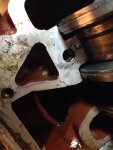misery
Petty Officer 3rd Class
- Joined
- Jul 18, 2010
- Messages
- 98
Hi guys. I have a friend with a 1980 evinrude 115 thats taking water into the bottom port side cylinder. The head gasket is new and the head looks flat. There are some casting flaws in the exhaust ports, but I don't think they lead to water. Is there a way to test anything to check for a cracked block or bad gaskets without dismantling the motor? What are the common problems that could cause a cylinder to take in water? thanks for the help.




















